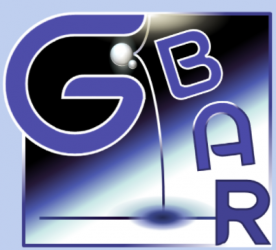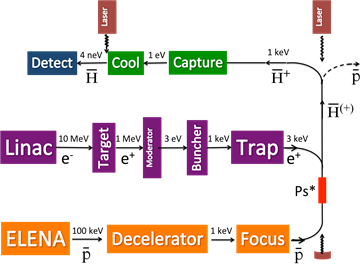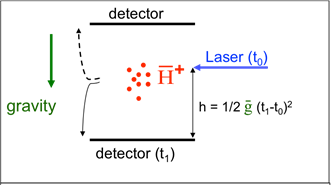Live from CERN - What does antimatter say when it falls?
Although the title of this post may sound like a stupid joke, we actually scientifically does not know the answer and are trying to learn it. At least, people at CERN will be trying in about a year!
So, what does antimatter do when it falls? Short answer:
AAAAAAAHHHHHHHH!!!
Longer but still short answer: we guess that it does “AAAAAAAHHHHHHHH!!!” The word ‘guess’ is the keyword here!
This guess will hopefully be confirmed in a couple of years from now. If not, this would mean we do not understand much about how the universe works. Which is also exciting in the sense that it opens the door to many new theoretical developments!
THE GBAR EXPERIMENT AT CERN
The question I want to address with the post of today has been inspired by my reading the latest CERN bulletin [1,2]. There was an article about one of the numerous antimatter experiments that will be ongoing very soon at CERN, the so-called GBAR experiment[3].

[image credits: GBAR @ CERN]
In a nutshell, this experiment aims to study the free fall of an ultracold antihydrogen atom in the gravitational field of the Earth.
In other words, this consists of a test of how antimatter reacts with gravity, one of the fundamental question of physics that has not been answered (yet).
The idea behind this experiment is simple. In a few words (more details below), antihydrogen atoms are cooled down to a temperature less than 0.01 K (this means -273.14 Celsius or -459.65 Farenheit), then trapped so that they are able to free fall on a distance of 20 centimeters. From there, scientists are watching!
Although this may sound like a short fall, it will actually be long enough for observers to study the behavior of the freely-falling anti-atoms.
THE NAME
Where is the GBAR name coming from?
This question and the related matter of scientists giving names to experiments / discoveries really starts to be a running joke around here ( @justtryme90 could confirm). And to perpetuate the tradition, the story behind the GBAR name is acronymic (good or bad, I let you judge).
One indeed always needs acronyms, and GBAR stands for ‘Gravitational Behavior of Antihydrogen at Rest’.
The funny fact behind is that the gravity acceleration constant is called g. Antimatter particles are on the other hand named as the matter particle counterparts, but with a bar on top of their name. Like a ‘pbar’ is an antiproton, an ’Hbar’ is an antihydrogen (anti H) atom, etc. (Note that I do not know how to add a bar on a top of a letter with markdown).
And then, gbar will just be the free-fall acceleration of antimatter particles in the terrestrial gravitational field. That sounds logical, doesn’t it?
FROM ANTIPROTONS TO ANTIHYDROGEN IONS

[image credits: GBAR @ CERN]
The way GBAR works is summarized in the picture on the right.
The story starts with antiprotons to be delivered by the ELENA decelerator that I have talked about three months ago. That consists of the orange chain in the schematic picture. We now have at this stage very slow antiprotons.
While antiprotons are antihydrogen nuclei, we are still not at the stage of having an antihydrogen atom. To this aim, we need to dress the nuclei with a positron.
This is done thanks to a new linear accelerator (in purple on the figure) that will produce accelerated electrons that will be smashed onto a tungsten target. As a results of this reaction, positrons are created and then trapped before being ejected to form a positron cloud.
The antiprotons are then sent through the positron cloud where they will form antihydrogen ions, i.e. particles made of one antiproton and two positrons. And not one like in the case of an atom.
The great advantage over an antihydrogen atom is that we have an electrically charged particle, an antihydrogen positive ion Hbar+.
While harder to form, antihydrogen atoms are electrically charged. That is a key properties for being able to manipulate them with the help of electric and magnetic fields.
THE GBAR PRINCIPLE

[image credits: GBAR @ CERN]
The freshly produced antihydrogen ions will then be gathered to a very well located position thanks to electric and magnetic fields that allow one to accelerate/decelerate them and control their trajectory.
As shown in the picture on the left, a laser will then be used to remove one of the positrons, so that the antihydrogen ions will form antihydrogen atoms (that are now electrically neutral).
At this stage, the only force that acts on the antihydrogen atoms is gravity. In the cavity where these atoms are, they can freely fall on 20 centimeters, right in front of the eyes of the scientists.
TAKE-HOME MESSAGE
The GBAR experiment is a novel type of experiment aiming to study the free fall of anithydrogen atoms in the terrestrial gravitational field.
The physics question at stake is one of the last one not yet addressed by experimental tests. One aims to verify the equivalence principle postulated by Einstein that tells us that the trajectory of a particle in a gravitational field is independent of its composition or structure when it is only submitted to gravity.
Now, we need to cross our fingers and wait a couple of years for the first results. :)
REFERENCES
- [1] The CERN bulletin of the 14th of March 2017, in French.
- [2] The March 2017 CERN article on GBAR, in English this time ;)
- [3] The official GBAR experiment public pages.
My guess is an antimatter particle says BOOOMMM if it falls on earth.
Maybe a small boom ^^
Thank you for this (very nicely written) article. :-)
You are very welcome!
Haha... thanks for the humorous approach to a serious topic.
You are welcome! ^^
We truly should come up with better names. I suppose gbar isn't too bad, except for the fact that the researchers were clearly trying to be punny. :)
It is indeed pretty good compared to others. Take for instance this post from @busser with the famous CFBDSIR 2149-0403 ^^
CFBDSIR 2149-0403 just rolls right off the tongue.
:D
Oh wow, 6 cents. Nice.
Welcome to the new shining world!

Totally! Need to get sunglasses :D
I am also giving 100% vote to comments now (I think it is actually the best way to spend my VP).
I'm not a scientist, but...is this something we really need to know???
We want to understand the universe. That is part of it.
as usual always interesting stuff.
Thanks a lot :)